Carolingian Dynasty and Ancestry (the road to Charlemagne) including Alfred the Great
Sources:
Verified lineage to James Arthur Johnson:
- Geni.com: Master Profile for Beatrice de Vermandois and reputable pages thereof
- WikiPedia: Beatrice of Vermandois and articles thereof
- Britroyals: Royal Family Tree (849-present) - ancestral lines from my ancestor St. Margaret, Queen of Scots back to Alfred the Great
- The Royal Family: Alfred 'The Great' (r. 871-899)
- Trees of Blue: British Royal Family Trees: King Alfred the Great Family Tree (849-899)
- Wikipedia: Alfred the Great and reputable pages thereof
- WikiPedia: Charles, Duke of Lower Lorraine
- Culpepper Family Tree: Elstrude and pages thereof
!!! NOTE !!! Per Culpeper ancestral research, this ancestrty is not yet verified as being through the Culpeper line. However, there is a verified line down to James Arthur Johnson through Pepin II, lord of Péronne and through one of the sons of Alfred the Great. Verified lines are denoted by solid lines as opposed to dashed lines. NOTE: You may have to scroll horizontally to see all of this page.
| | | | | | | | ↓ |
↑ | | | |
↑ | | | |
Æthelred Mucel Ealdorman of the Gaini, an Anglo-Saxon noble from Mercia Eadburh. She is claimed to be a descendant of King Coenwulf of Mercia and his wife Elfrida || ↓ |
a margrave (German: Markgraf) Brun or Brunhart and his wife, Gisla von Verla |? ↓ |
Poppo I |d. 839-841 a Frankish count in the Grapfeld (Grabfeld) from 819-839. Probably a descendant of the Robertian count Cancor, he became the ancestor of the Frankish House of Babenberg (Popponids). His father may have been Rodbert and his brother may have been Robert of Hesbaye | ↓ |
| | ↓ |
Gisela is the sister of Charles the Bald also seen in this tree. |
My verified line → | |||||||||||||
Charles the Bald b. 13 June 823 d. 6 October 877 King of West Francia (843-77), King of Italy (875-77) and Holy Roman Emperor (875-77, as Charles II) "After a series of civil wars that began during the reign of his father, Louis the Pious, Charles succeeded by the Treaty of Verdun (843) in acquiring the western third of the Carolingian Empire. He was a grandson of Charlemagne and the youngest son of Louis the Pious by his second wife, Judith." (source) His sister is Gisela, also seen in this tree. |
m. 842 | Ermentrude of Orléans b. 27 September 823 d. 6 October 869 |
 |
my verified line → my verified line →  my verified line →  |
Alfred the Great
King of Wessex 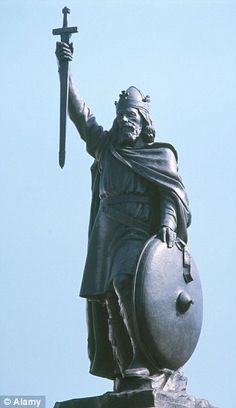 d. 26 October 899 (Old English: Ælfred, Ælfræd, "elf counsel" or "wise elf") was King of Wessex from 871 to 899. 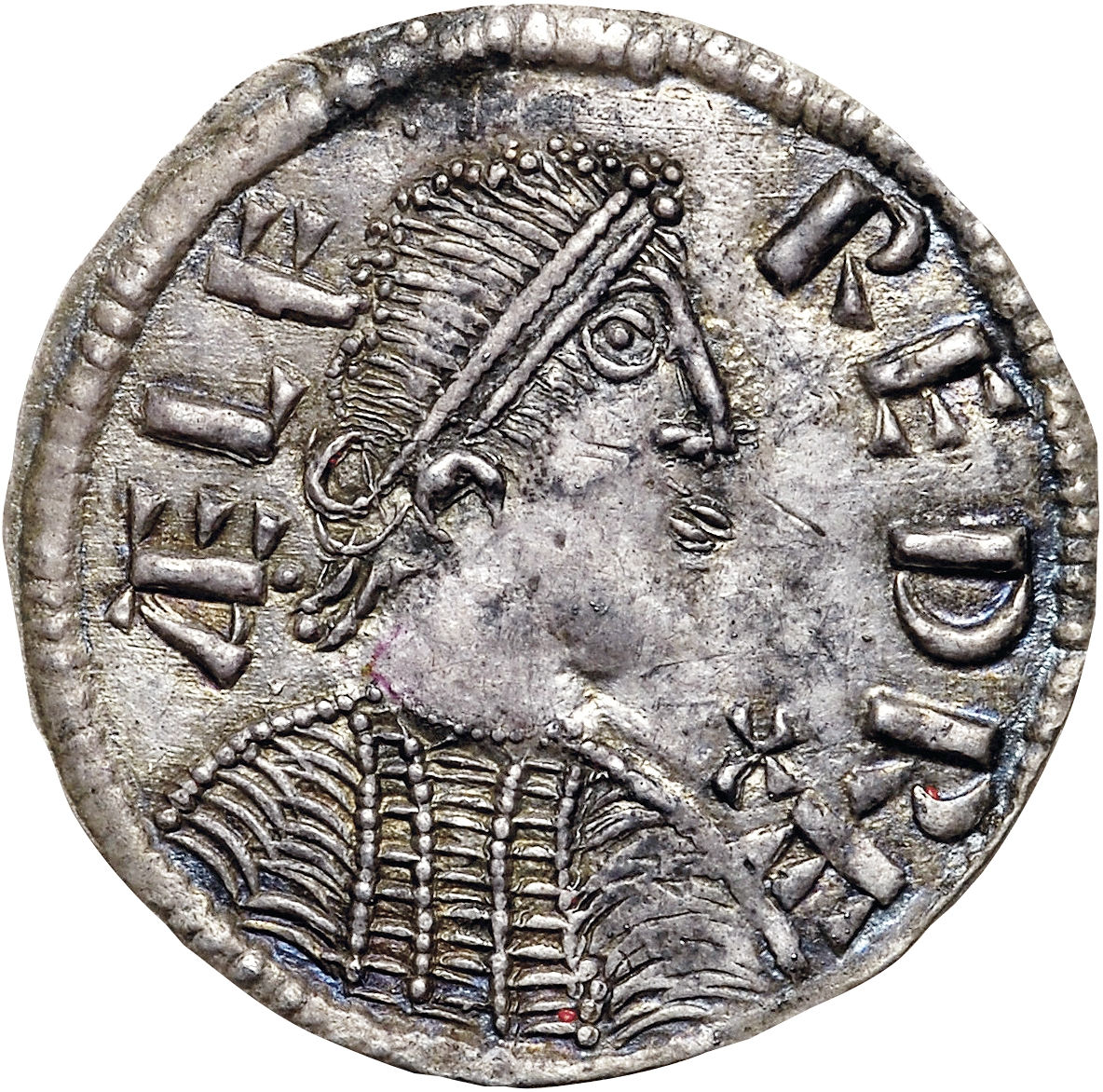

Ealhswith
(Ealswitha) 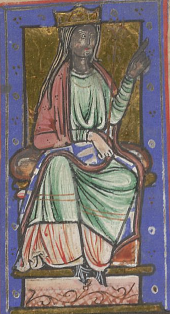 d. 5 December 902 According to the historian Cyril Hart she was a descendant of King Coenwulf of Mercia. m. 868
Alfred successfully defended his kingdom against the Viking attempt at conquest, and by the time of his death had become the dominant ruler in England. He is one of only two English monarchs to be given the epithet "the Great", the other one being Cnut the Great. He was also the first King of the West Saxons to style himself "King of the Anglo-Saxons". Details of Alfred's life are described in a work by the 10th-century Welsh scholar and bishop Asser. A devout Christian, Alfred had a reputation as a learned and merciful man of a gracious and level-headed nature who encouraged education and improved his kingdom's legal system, military structure and his people's quality of life. (source) |
| | | | | | | ↓ |
Liudolf, Duke of Saxony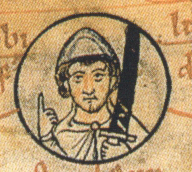 b. ca. 805/820 d. 11/12 March 866 a Carolingian office bearer and count in the Duchy of Saxony from about 844. The ruling Liudolfing House, also known as the Ottonian dynasty, is named after him as he is its oldest verified member. m. Oda of Billung |
← my verified line |
Henry of Franconia
d. 836 possibly a son or grandson of Count Poppo of Grapfeld, one of the first Babenbergs, was the most important East Frankish general during the reign of Charles the Fat. He was variously titled Count or Margrave of Saxony and Duke of Franconia. (source)
Henry was the ancestral lord of a castle, Babenberg, on the River Main, around which the later city of Bamberg was built. He enjoyed the favour of Charles the Fat and was his right-hand man in Germany during his reign. He led a surprise strike on a force of Vikings prior to the Siege of Asselt, but it was unsuccessful. When, in 885, Charles summoned Hugh, Duke of Alsace, and Godfrey, Duke of Frisia, to a court at Lobith, it was Henry who arrested them and had Godfrey executed and Hugh imprisoned on Charles' orders.
In 884, when Charles succeeded to the throne of West Francia, he sent Henry there to hold the March of Neustria against the Vikings. In 886, he was sent to aid the besieged of Paris. He did not stay long but returned later that year with Charles. However, he died in a skirmish with the Vikings while en route. (source) |
Saxon leader Widukind He was an opponent of Charlemagne during the Saxon Wars (777-785) |
Pépin II, lord of Péronne lord of Senlis, Pèronne, and Saint Quentin b. ca. 817, Vermandois, Picardy, France d. after 850, Milan, Milano, Lombardia, Italy
|
|||||||||||
|
| | | | | | | | | | | | | | | | | | | | | | | | | | | | | | | | | | | | | | | | | | | | | | ↓ |
| | | | | | | | | | | | | | | | | | | | | | | | | | | | | | | | | | | | | | | | | | | | | | ↓ |
|
↓ ← my verified line (source) Edward the Elder (Eadweard cyning)
King of England b. ca. 874 d. 17 July 924, Farndon, Cheshire, England m. before 899
| ↓ |
↓ Æthelstan (Athelstan)
(Regarded the first actual King of England and one of the greatest Anglo-Saxon kings) b. ca. 893-895, Wessex, England d. 27 October 939, Cloucester, England |
↓ |
| | | | | | | | | | | | | | | | | | | | | | | | | | | | | | | | | | | | | | | | | | | | | | | ↓ |
← my verified line | | | | | | | | | | | | | | | | | | | | | | | | | | | | | | | | | | | | | | | | | | | | | | | | | | ↓ |
| | | | | | | | | | | | | | | | | | | | | | | | | | | | | | | | | | | | | | | | | | | | | | | ↓ |
My verified line → | | | | | | | | | | | | | | | | | | | | | | | | | | | | | | | | | | | | | | | | | | | | | | | ↓ |
 |
||||||||||||
|
|
| | | | | | | | | | | | | | | | | ↓ |
| | | | | | | | | | | | | | | | | | | ↓ |
← my verified line |
| | | | | | | | | | | | | | | | | ↓ |
A son of Widukind? || | | | | | | | | | | | | | ↓ |
My verified line → | | | | | | | | | | | | | | | | | | | | ↓ |
 |
|||||||||||||
|
|
King Baldwin the Bald, Count of Flanders son of Princess Judith and King Baldwin Iron-Arm of Flanders b. ca. 863 d. ? |
m. | Elfrida, daughter of Alfred the Great and Ealhswith | | | | | | | | | | | | | | | | | | | | | | | | | | | | | ↓ |
← my verified line.
→Hedwiga is thought to have been a daughter of Henry of Franconia (so, unverified line here) |
| | | | | | | | | | | | | | | | | | | | | | | | | | | | ↓ |
| | | | | | | | | | | | | | | | | | | | | | | | | | | | ↓ |
My verified line → | | | | | | | | | | | | | | | | | | | | | | | | | | | | | ↓ |
 |
|||||||||||
| | | ↓ descendants through their son King Arnulf the Great |
Otto I, Duke of Saxony Otto (or Oddo) the Illustrious (der Erlauchte) 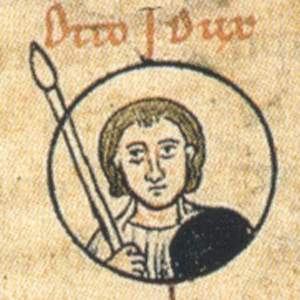 b. ca. 836/851 d. 30 November 912 "He was father of Henry the Fowler and grandfather of Otto the Great. he also was father-in-law of Zwentibold, Carolingian King of Lotharingia." (source) |
m. | Hedwiga (a.k.a. Hathui of Babenberg) 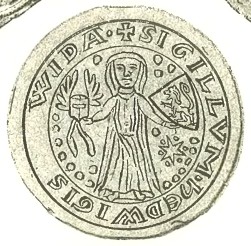 Hedwig, Gemahlin Heinrich X., Vogt von Weida |
A grandson of
Widukind? |
| | | ↓ Reginhart? a great grandson of Widukind? Mathilda
m.
|
↓ Theodoric (Dietrich) of Ringelheim b. ca. 872 d. 916 Reinhild
(Reinhildam) b. ca. 870 d. ca. 917 m.
|
Herbert I, Count of Vermandois, Count of Meaux, Count of Soissons, and lay abbot of Saint Quentin b. ca. 848, Vermandois, Normandy, France m. ca. 865 d. 902, killed in France Husband of Bertha de Morvois OR Lietgardis de Troyes →  |
His wife was either Bertha de Morvois a.k.a. Beatrice b. ca. 845-855 in Bohain, Aisne, Picardie, France m. ca. 865 d. 15 Jun 916 in Vermandois, Aisne, Picardie, Kingdom of France She was the daughter of Guerri I de Morvois (820-886) and Eva of Roussillon Countess of Morvois (825-862) according to this Find-A-Grave. She may be fictitious and the wife of Herbert I may simply be unknown according to this Geni.com OR another possibility is that his wife was Lietgardis de Troyes |
|||||||||||||||
| My verified line → | | | ↓ |
My verified line → | | | ↓ |
m. ca. 865 | |||||||||||||||||
| | | ↓ |
| | ↓ |
| | ↓ |
| | ↓ |
||||||||||||||||||
| My verified line → | | | | | | | | | | | | | | | | | ↓ |
My verified line → | | | | | | | | | | | | | | | | | ↓ |
| | | | | | | | | | | | | | | | ↓ |
|||||||||||||||||
| My verified line → | | | | | | | | | | | | | | | | | ↓ |
My verified line → | | | | | | | | | | | | | | | | | ↓ |
| | | | | | | | | | | | | | | | ↓ |
↑ | | |
||||||||||||||||
|
Henry the Fowler
(German: Heinrich der Finkler or Heinrich der Vogler; Latin: Henricius Auceps) (Henry's seal from a document of 30 March 925 with the words HEINRICUS REX) b. 876 d. 2 July 936 Duke of Saxony from 912 and the King of Germany from 919 until his death. Matilda of Ringelheim
Saint Matilda (or Matilda) 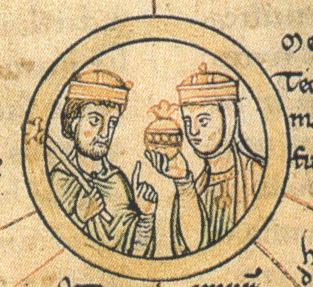 (Heinricus rex and Methildis regina, Chronica St. Pantaleonis, 12th century) b. ca. 895 d. 14 March 968 wife of King Henry I of Germany, the first ruler of the Saxon Ottonian (or Liudolfing) dynasty, thereby Duchess (consort) of Saxony from 912 and Queen (consort) of Germany (East Francia) from 919 until her husband's death in 936. (source) She is descended from the noble Immedinger family of medieval Saxony, descended from Saxon leader Widukind (see above) m. 909
First of the Ottonian Dynasty of German kings and emperors, he is generally considered to be the founder and first king of the medieval German state, known until then as East Francia. An avid hunter, he obtained the epithet "the Fowler" because he was allegedly fixing his birding nets when messengers arrived to inform him that he was to be king (source). Their eldest son Otto succeeded his father as King of Germany (East Francia) and years later was crowned Holy Roman Emperor in 962, thus ending the vacancy of this office begun in 924 with the death of Holy Roman Emperor Berengar I of Italy. Matilda lived to see the imperial crown restored under her son. Matilda's surname refers to Ringelheim, where her comital (of or relating to a count or earl) Immedinger relatives established a convent about 940 (source). |
Herbert II, Comte de Vermandois
(Count of Vermandois) (d. 23 Feb 943), Count of Vermandois, Count of Meaux, and Count of Soissons. He was the first to exercise power over the territory that became the province of Champagne m.
|| | | | | | | | | | | | | | | | ↓ |
||||||||||||||||||||
| | | ↓ |
| | ↓ |
| | ↓ |
| | ↓ |
||||||||||||||||||
| | | | | | | | | ↓ |
| | | | | | | | ↓ |
← my verified line | descendants through son Adalbert I, Count of Vermandois | | | | | | | | | ↓ |
|||||||||||||||||
| | | ↓ |
| | | | | | | | ↓ |
| | | | | | | | ↓ |
| | | | | | | | ↓ |
||||||||||||||||||
| Giselbert (Gilbert), Duke of Lorraine b. ca. 890 d. 2 October 939 |
m. | Gerberga of Saxony (also Gerberga of France) 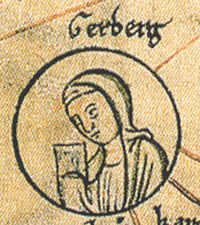 b. ca. 913 d. 5 May 968/9 or 984? She was a member of the Ottonian dynasty and a descendant of Charlemagne. Giselbert (Gilbert), Duke of Lorraine was her first husband. After his death, she would marry Louis IV. |
| ↓ descendants through their daughter Hedwig's marriage to Hugh the Great, a marriage which produced Hugh Capet |
← my verified line |
| | ↓ descendants through their daughter Elstrude |
||||||||||||||||
| | | ↓ |
|||||||||||||||||||||
| descendants by his marriage to Gerberga of Saxony via their daughter Gerberge of Lorraine | |||||||||||||||||||||
Developed in July 2015.